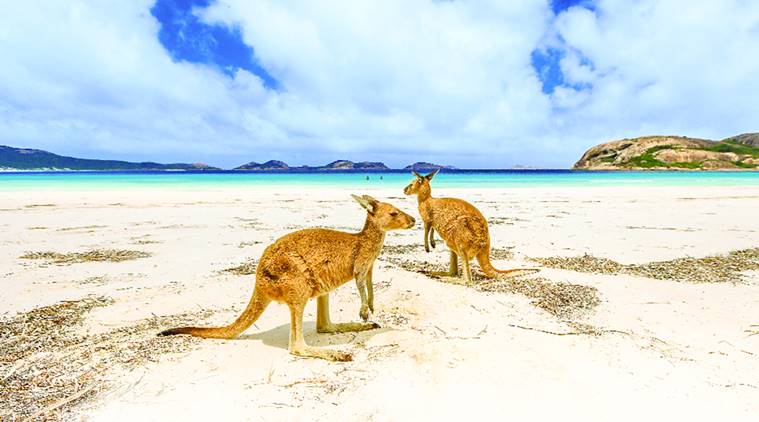 You will see kangaroos across the eponymous island. (Source: Thinkstock Images)
You will see kangaroos across the eponymous island. (Source: Thinkstock Images)
There are 4,000 people in Kangaroo Island (KI), located off the mainland of south Australia. But, it’s the undocumented population — animals, birds, and insects — that make this tiny island a wildlife paradise.
It’s like one large national park, without any borders. “About a quarter of the island is home to national and conservation parks. It’s why we find so many animals here in their natural habitats,” says Nikki Redman, my guide from the Kangaroo Island Odysseys Tour. She starts listing the animals and I run out of fingers to count on. There are rabbits, wallabies, foxes, emus, koalas, pelicans, echidnas, bandicoots, goannas, wombats, fur seals, penguins and the Island’s own type of kangaroo.
Redman has lived in KI all her life. She has petted fur seals, swam with the dolphins and photographed male kangaroos playing. My first encounter with many of the animals she has mentioned is through her book of photographs. It would take more than the two days I have in hand to explore KI’s wildlife, so, I get an abridged version.
Our first stop is Seal Bay, which is home to about 800 sea lions. It is breeding season, which means “the males have no energy left after chasing the females around”. At the beach, all I can see are brown bodies flopped about in the sand. The sea lions are undeniably cute, with snouts that remind me of my dog back home. They eye us warily but don’t stir. The only active ones are the pup, either nursing or playing with their fathers.
I get to see more seals, slightly more active ones, at Admirals Arch. The natural landmark is a rock bridge created by years of erosion; it has stalactites of sandstone and limestone. Here, I glimpse the long-nosed brown fur seals swimming gracefully in the water, and climbing out using their bellies and flippers. Redman points out the little pools in the rocks that are filled with seal pups. It’s their version of a kiddie pool, and the pups splash about without supervision.
At lunch, I’m lucky to spot a solitary koala, hugging a tall eucalyptus tree. The meal is excellent, slices of beef, a delicious cold salad and wine, but I’m excited about my evening plan: coffee with the kangaroos.
We drive to Grassdale, which is part of Kelly Hill Conservation Park, about an hour away from Kingscote. “This was once a farm run by Lucy Edwards. When her husband died, she was left to clear the land and did most of the work herself. When it got too much for her, she sold it to the park,” says Redman, handing me a cup of strong black coffee. Here, we spot the kangaroos, hungrily pecking away at the dry and withered grass. “We don’t encourage feeding the animals, even if they are starving. Our food isn’t meant for them and they need to be able to forage themselves,” she says. We keep our distance but a few alert ones — their hearing is exceptional — hop away and hide. The kangaroos on the island are usually grey or chocolate brown, and are shorter and more muscular than their Australian counterparts. And more romantic too — during mating season, the male kangaroos will romance the female, stroking and cuddling her till she softens.
I spot kangaroos the next morning too, outside the town of Kingscote, hiding in a farm. They don’t seem perturbed by the sheep, cows and dogs around them. There are many farms dotting the island. “The main industry on the island is farming, sheep for dairy and Murray Greys and Angus cows for meat. Earlier, sheep were reared for wool but when demand went down in the 1980s, many farms lost their livelihood,” says Redman. They had to diversify — olives, lavender, eucalyptus, grapes, and even lobster farming.
Dave Clifford of Clifford’s Honey Farm started rearing bees as a hobby. When wool prices went down, he decided to expand on this hobby and the honey farm was born in 1993. It’s only at KI that we can find the last genetically pure strain of Ligurian bees. “They were brought in from Italy by ship. KI has become a sanctuary for them. There are 30 beekeepers on the islands and 3,000 hives that produce 200 tonnes of honey,” says Clifford. He takes me around his shed, explaining the process of extracting the honey and wax. The migratory type of beekeeping means that Clifford’s hives are spread across the island; there’s just one small one at the farm.
I say goodbye to the bees and head out in search of the birds. My evening coffee this time is in the company of pelicans, at Emu Bay. The birds sit quietly on the rocks and tyres dotting the shore near the fishing jetty. It appears as if they are waiting for the stray fishermen at the jetty to haul in their catch before swooping in and snatching them. I walk down the jetty and sit on the solitary bench, watching the fishermen and the pelicans. On the beach, I spot my favourite animal, dogs bounding about and barking at the birds. It’s quite the panorama — the blue sky, the aquamarine water, the black and white birds and in the distance, brown and green hills.
In KI, as Redman says, there really is something something special around every corner.
Joanna Lobo is a freelance writer based in Mumbai.